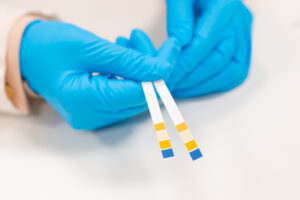Cocaine is an addictive stimulant with the potential to cause severe health problems. Only found in the leaves of the coca plant in South America, cocaine has no lab-made counterpart. It acts as a powerful dopamine enhancer, rewarding repeated use. The rush of dopamine becomes a craving to feel the effects again, leading to addiction.
Cocaine will often have other substances mixed in with it to make more profit in sales. This filler can be anything that the seller has on hand, and people may suffer health problems from the fillers in addition to the cocaine. Cocaine can also be processed in home labs into crack, a smokeable version that produces a brief but intense high.


Cocaine Rehab in Riverside County, CA
Cocaine is a powerfully addictive stimulant. For thousands of years, people in South America have chewed and ingested coca leaves, the source of cocaine, for their stimulant effects. The purified chemical, cocaine hydrochloride, was isolated from the plant more than 100 years ago.
Cocaine is a Schedule II drug, which means that it has a high potential for abuse but can be administered by a doctor for legitimate medical uses, such as local anesthesia for some eye, ear, and throat surgeries. As a street drug, cocaine appears as a fine, white, crystalline powder.
The base form of cocaine is created by processing the drug with ammonia or sodium bicarbonate and water, then heating it to remove the hydrochloride to produce a smokable substance. The term crack, which is the street name given to freebase cocaine, refers to the crackling sound heard when the mixture is smoked.
The addictive power of cocaine and crack comes from the drug’s action on the dopamine system in the brain. Like other addictive substances, cocaine acts on this system to trigger feelings of enjoyment and feeling rewarded for the behavior. Unlike other drugs, cocaine binds to receptors on nerve cells that use dopamine to send signals. Dopamine passes through an empty space between cells called the synapse, and after it does its job, it gets cleared out, and the system resets. Cocaine prevents the dopamine from being cleared out, so the receiving nerve cell, overwhelmed with signals, transmits a rush of enjoyable feelings.
After repeated and regular use, however, cocaine starts to change the brain physically. The overstimulating of the dopamine system starts to “burn out” nerve cells, causing receptors to stop responding to dopamine as well. This causes tolerance development since the person using the substance must keep increasing the dose to overcome the damage to their nerve cell receptors. Some people addicted or dependent on cocaine experience damage to their frontal lobes, which hinders decision-making, planning, and self-awareness.
Short-term symptoms of cocaine use can include:
- Raised blood pressure
- Increased body temperature
- Excitement and energy
- Hypersensitivity to lights and sounds
- Irritability or impatience
Long-term symptoms of cocaine use include:
- Weight loss from appetite suppression
- Nosebleeds if using the drug by snorting
- Infections from injecting the drug
- Lung damage from smoking it
Raised blood pressure after cocaine use contributes to almost all cocaine-related deaths. The rapid rise in very high blood pressure can trigger heart attacks, irregular heartbeat, or an aneurysm, even in a healthy young person. Body temperature may also reach dangerous levels and require medical assistance to cool it.
Research has found that for every three people presenting in the emergency room with a drug-related problem, one had cocaine in their system. The usual cause of these visits includes heart palpitations or other cardiac symptoms. People can die from these symptoms and should seek medical attention, even if they turn out not to require treatment.
Immediate cocaine use can sometimes lead to aggressive, irrational, paranoid behavior. The National Institute on Drugs Abuse’s (NIDA) cocaine research report also found that people with chronic substance use disorder relating to cocaine often had a suppressed immune system.
How is Cocaine Addiction Treated?
No FDA-approved medications exist to treat cocaine addiction. The damaged dopamine system needs to reset itself, and the only way to do this is with time. Most facilities will start cocaine treatment with detox.
Cocaine withdrawal symptoms do not have the same physical severity as opioid or similar withdrawals. Cocaine addiction directly affects dopamine receptors, so most people experience psychological effects while in detox.
People might experience:

- Cravings for cocaine
- Depression
- Anxiety
- Paranoia
- Nightmares
- Difficulty concentrating
While no medication prevents these symptoms, most people find them unpleasant but manageable, especially in the right setting for support and treatment.
How Does Everlast Treat Cocaine Addiction?
Everlast Recovery Centers treats cocaine addiction with the methods most recommended by the NIDA, especially cognitive-behavioral therapy (CBT). Like other drugs with no medical assistance available, people in early recovery from cocaine addiction can only use the skills taught to them by the clinically experienced treatment team.
For people in recovery from cocaine addiction, physical activity can help stimulate the natural release of dopamine and other feel-good neurotransmitters in the brain.

Everlast helps people find methods for generating those natural positive feelings so clients can learn to experience pleasure without cocaine.
Everlast also uses various other therapeutic modalities and activities to ensure each individual finds the right course of treatment for their substance use disorder. For example, 12-Step programs and similar recovery support groups like SMART Recovery have proven effective in helping people stay sober. Everlast introduces people to the concepts of the 12-Step program and other recovery support to allow clients to find the best path towards recovery.







